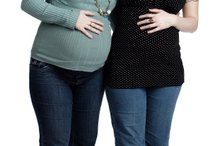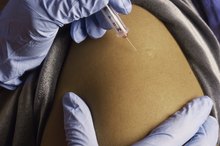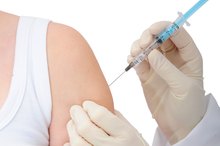Hormones to Help Get Pregnant
Getting pregnant, a complicated hormonal event, requires an interplay of hormones released at exactly the right time to develop, mature and release an egg from the ovary, and then to implant it in the uterus. Women having trouble getting pregnant may be prescribed different hormones at different times of the menstrual cycle to help them achieve pregnancy 1.
Follicle Stimulating Hormone
Follicle stimulating hormone, or FSH, produced by the pituitary gland at the beginning of the menstrual cycle, stimulates follicles -- which hold the eggs -- in the ovary to grow 1. Women undergoing fertility treatments are often prescribed synthetic or laboratory made forms of FSH starting at the beginning of the menstrual cycle to encourage follicle development 1. FSH levels rise abnormally high as women age, in an effort to get the aging ovaries to produce an egg. Rising FSH levels can also signal the start of menopause when most eggs have already been released. Naturally high FSH levels indicate a low number of good follicles in the ovary and a decreased chance of getting pregnant.
- Follicle stimulating hormone, or FSH, produced by the pituitary gland at the beginning of the menstrual cycle, stimulates follicles -- which hold the eggs -- in the ovary to grow 1.
- Rising FSH levels can also signal the start of menopause when most eggs have already been released.
Estrogen
Does Breastfeeding Cause Low Progesterone?
Learn More
Estradiol, a form of estrogen, the dominant female hormone, is produced by the ovary as a follicle in the ovary starts to develop. If estradiol levels don’t rise, the egg won’t develop properly. While estradiol is essential for getting pregnant, a woman’s body must make this hormone on its own for pregnancy to occur. Taking estradiol pills won’t help a woman get pregnant, because her body will think she already has enough estradiol and won’t make any more. The one exception is women who have abnormally high FSH level due to decreased ovarian reserve. Abnormally high FSH levels prevent egg development.
- Estradiol, a form of estrogen, the dominant female hormone, is produced by the ovary as a follicle in the ovary starts to develop.
- Taking estradiol pills won’t help a woman get pregnant, because her body will think she already has enough estradiol and won’t make any more.
Luteinizing Hormone
Like FSH, luteinizing hormone, or LH, is produced by the pituitary. LH rises just before ovulation, or release of the mature egg from the ovary. , LH surge is a short, high burst that's required for ovulation. Women who don’t produce adequate LH at the time of ovulation may not release an egg from the ovary.
- Like FSH, luteinizing hormone, or LH, is produced by the pituitary.
- Women who don’t produce adequate LH at the time of ovulation may not release an egg from the ovary.
Progesterone
High Testosterone & Pregnancy
Learn More
Progesterone, produced by the corpus luteum, which represents new growth of special cells that make progesterone along with estrogen, helps a growing embryo implant in the uterine lining. Low levels of progesterone can cause problems maintaining the lining and may result in very early miscarriages. Giving progesterone helps to maintain a pregnancy in women with low progesterone levels. Most women undergoing fertility treatments take progesterone supplements.
- Progesterone, produced by the corpus luteum, which represents new growth of special cells that make progesterone along with estrogen, helps a growing embryo implant in the uterine lining.
- Giving progesterone helps to maintain a pregnancy in women with low progesterone levels.
Human Chorionic Gonadotropin
Human chorionic gonadotropin, or hCG, is produced by the growing placenta after an embryo implants and is the hormone measured by pregnancy tests. Women undergoing artificial insemination to induce ovulation, or the release of the mature egg from the follicle in the ovary, may also take hCG, because it acts similarly to LH, Chicago IVF explains. Women undergoing IVF treatments take hCG to mature the egg in the follicle so it can be removed with a needle during an egg retrieval.
Related Articles
References
- Merck Manual: Menstrual Cycle
- Khattar D, Sodhi C, Parmod J, Dutta A. Correlating Estrogen Levels and Cognitive Functions in Regularly Menstruating Females of Reproductive Age Group and Post Menopausal Women of North India. J Family Reprod Health. 2015;9(2):83-88.
- Saran S, Gupta BS, Philip R, et al. Effect of hypothyroidism on female reproductive hormones. Indian J Endocrinol Metab. 2016;20(1):108-113. doi:10.4103/2230-8210.172245
- Ajayi O, Charles-Davies M, Anetor J, Ademola A. Pituitary, Gonadal, Thyroid Hormones and Endocrine Disruptors in Pre and Postmenopausal Nigerian Women with ER-, PR- and HER-2-Positive and Negative Breast Cancers. Med Sci (Basel). 2018;6(2):37. doi:10.3390/medsci6020037
- Thomas MP, Potter BV. The structural biology of oestrogen metabolism. J Steroid Biochem Mol Biol. 2013;137:27-49. doi:10.1016/j.jsbmb.2012.12.014
- Hall JE, Taylor AE, Hayes FJ, Crowley WF. Insights into hypothalamic-pituitary dysfunction in polycystic ovary syndrome. J Endocrinol Invest. 1998;21(9):602-611. doi:10.1007/BF03350785
- Norwitz ER, Caughey AB. Progesterone supplementation and the prevention of preterm birth. Rev Obstet Gynecol. 2011;4(2):60-72.
- Abdalla H, Thum MY. An elevated basal FSH reflects a quantitative rather than qualitative decline of the ovarian reserve. Hum Reprod. 2004;19(4):893-898. doi:10.1093/humrep/deh141
- Mihailidis J, Dermesropian R, Taxel P, Luthra P, Grant-Kels JM. Endocrine evaluation of hirsutism. Int J Womens Dermatol. 2015;1(2):90-94. doi:10.1016/j.ijwd.2015.04.003
- Roth MY, Amory JK. Testosterone for low libido in postmenopausal women? Expert Rev Endocrinol Metab. 2009;4(2):131-133. doi:10.1586/17446651.4.2.131
- De Leo S, Lee SY, Braverman LE. Hyperthyroidism. Lancet. 2016;388(10047):906-918. doi:10.1016/S0140-6736(16)00278-6
- Smith A, Eccles-Smith J, D'Emden M, Lust K. Thyroid disorders in pregnancy and postpartum. Aust Prescr. 2017;40(6):214-219. doi:10.18773/austprescr.2017.075
- Centers for Disease Control and Prevention. Appendix D: Contraceptive Effectiveness/Recommendations and Reports. MMWR. April 25, 2014;63(RR04):47-47.
- Davis S, Wahlin-Jacobsen S. Testosterone in women—the clinical significance. Lancet Diabetes Endocrinol. 2015 Sept;3(2):980-92. doi:10.1016/S2213-8587(15)00284-3
- Kumar P, Magon N. Hormones in pregnancy. J Nigerian Med Assn. 2012;53(4):179-83. doi:10.4103/0300-1652.107549
- Shapiro M. (2012). Menopause Practice: A Clinician's Guide (4th Edition). Mayfield, Ohio: North American Menopause Society (NAMS).
Writer Bio
A registered nurse with more than 25 years of experience in oncology, labor/delivery, neonatal intensive care, infertility and ophthalmology, Sharon Perkins has also coauthored and edited numerous health books for the Wiley "Dummies" series. Perkins also has extensive experience working in home health with medically fragile pediatric patients.









